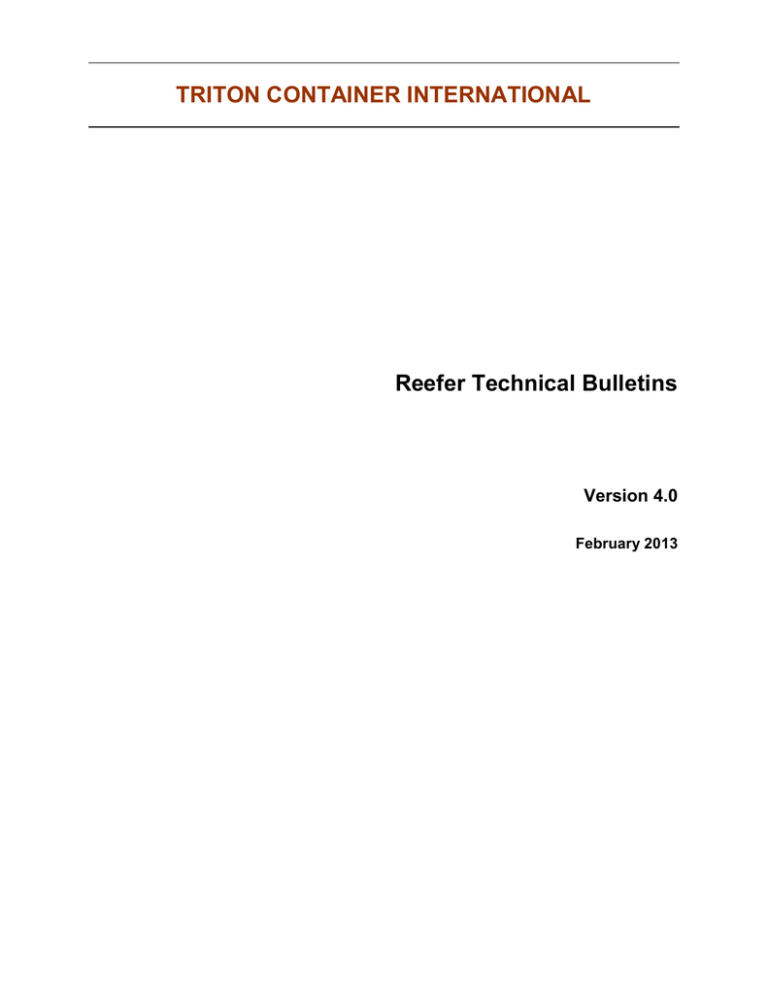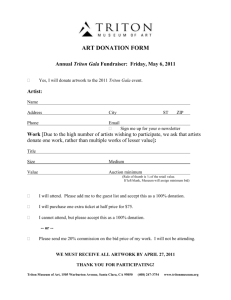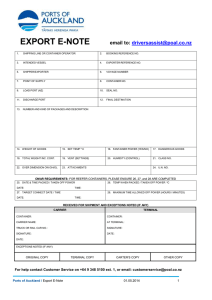Reefer Technical Bulletins
advertisement

TRITON CONTAINER INTERNATIONAL Reefer Technical Bulletins Version 4.0 February 2013 Triton Container Reefer Technical Bulletins Table Of Contents (Hold “Ctrl” button and click on any item below to go directly to that section of the manual.) 1 INTRODUCTION ............................................................................................................................. 3 2 REFRIGERATED CONTAINER STRUCTURE .............................................................................. 4 2.1 2.2 3 HGSS DOOR PAINT FAILURE ...................................................................................................... 4 SIDE PANEL, TOP SIDE RAIL, OR BOTTOM SIDE RAIL OUT OF ISO ............................................... 9 REFRIGERATED CONTAINER MACHINERY ............................................................................. 11 3.1 3.2 3.3 3.4 POWER CORD .......................................................................................................................... 11 RECIPROCATING COMPRESSOR PAINT FAILURE ......................................................................... 18 COOLING UNIT TIR W IRES AND FASTENERS .............................................................................. 24 ELECTRICAL CONTACTOR / WIRE TERMINAL............................................................................... 28 2 Last Updated February 8, 2013 Triton Container 1 Reefer Technical Bulletins Introduction The Institute of International Container Lessors (IICL) has issued the General Guide for Refrigerated Container Inspection and Repair (“IICL Reefer Manual”). The IICL Reefer Manual defines the inspection and repair standards for the Triton refrigerated container fleet. However, there are some areas that the IICL Reefer Manual does not address, or addresses in an incomplete or ambiguous manner. These areas are commonly called “gray areas”. A major source of gray areas is the difference between shipping line in-service and IICL offhire repair standards. Shipping line in-service repair standards are quite often lower than IICL offhire repair standards. This results in offhires with “non-conforming repairs” (repairs that do not conform to IICL standards), which are commonly called “improper repairs.” These repairs are “improper” in the sense that they do not fully meet the IICL technical standards, or they do not meet the generally accepted level of workmanship for IICL repairs. The technical bulletins within this document describe Triton’s policies and procedures regarding refrigerated container gray areas for both structure and machinery. Each bulletin addresses a condition, presents a series of photos showing a wear and tear, damage, or improper repair condition, and covers the following points: 1) 2) 3) 4) The specific condition. Repair action to be taken, if any. The account that pays for the repair. Any additional information that may be of use to the reader. Note that certain cases local differences may exist that require inspection or repair techniques which are not covered in these bulletins or in the IICL publications. In these situations, the Triton regional Maintenance and Repair Manager’s decision will override all other criteria. 3 Last Updated February 8, 2013 Triton Container 2 Reefer Technical Bulletins Refrigerated Container Structure 2.1 HGSS Door Paint Failure Description: Procedures for addressing paint failure on HGSS door panels. Applies To: All Triton refrigerated containers with HGSS exterior door panels: TRIU 661000 – 661099 TRIU 815000 – 815099 TRIU 823000 – 824999 TRIU 831000 – 831199 TRIU 833625 – 837924 TRIU 838000 – 838899 Condition Details: Door panel paint is cracking and peeling on more than 30% of the door panel area OR the paint failure has affected the prefix, serial number and ISO decals. Action: a. Remove all door paint and decals with paint remover and a non-metallic scraper. Note that this repair does NOT require the removal of the door gear, gaskets, and data plate. b. Wash the door panels with fresh water and let dry. c. Passivate door panels with pickling liquid specifically for use on stainless steels. d. Water wash and let doors dry completely. e. Reapply Triton serial number and all ISO required decals. Note that it is not necessary to reapply the Triton or classification logo. Account: Repair of HGSS door paint failure should be considered W&T and should be estimated for Triton’s account. 4 Last Updated February 8, 2013 Triton Container Reefer Technical Bulletins Door paint peeling requiring repair (more than 30% of door panel paint area peeling). 5 Last Updated February 8, 2013 Triton Container Reefer Technical Bulletins Door paint peeling not requiring repair (Prefix, Serial number, and ISO markings intact and not more than 30% of door panel paint area peeling). 6 Last Updated February 8, 2013 Triton Container Reefer Technical Bulletins No action required on doors with paint cracking and peeling only on the periphery of the door panel. At least 30% of the door panel area must be affected OR the prefix, serial number, and ISO markings must be affected. 7 Last Updated February 8, 2013 Triton Container Reefer Technical Bulletins Completed door paint removal and decal reapplication. 8 Last Updated February 8, 2013 Triton Container 2.2 Reefer Technical Bulletins Side Panel, Top Side Rail, Or Bottom Side Rail Out Of ISO Description: Inspection criteria for side panel, top side, and bottom side rails out of ISO tolerances. Applies To: All refrigerated containers. Condition Details: The current IICL Guide for Refrigerated Container Inspection & Repair states that any deformation to the container EXCEPT the end frame components and refrigeration unit that exceeds ISO tolerances by more than 10mm requires repair. The most common area for damage that causes this deformation seems to be at the bottom side rail and side panel at the center of the unit (see photos below). Identification and estimation of this type of damage is difficult, repairs are extensive and can be very costly, and it rarely ends up restoring the unit to the original condition. In most cases the repair ends up being weaker and more prone to delaminated than the original damage condition. Action: Triton’s damage criteria for side panels and top and bottom side rails is revised to ISO + 20mm for all reefers. Note that this is an internal change affecting Triton refrigerated units only, and the IICL criteria remains as it is. Please instruct all reefer depots to only estimate side panel and top and bottom side rail areas for repair that exceed ISO +20mm or that exceed the Triton delamination criteria. Account: Any damages that exceed this criteria should be written up for the customer’s account. 9 Last Updated February 8, 2013 Triton Container Reefer Technical Bulletins 10 Last Updated February 8, 2013 Triton Container Reefer Technical Bulletins 3 Refrigerated Container Machinery 3.1 Power Cord Description: Power cord splicing, repair, and replacement. Applies To: All reefer machinery. Condition Details: Cut, damaged, or missing power cord. Action: a. Minimum acceptable cable length 15m for 20', and 18m for 40', however if cable is damaged within 2m of the plug, instead of adding a splice the damaged section of cable can be removed and the plug reattached. Note that this only applies to cables that are already of acceptable length and would leave a final cable length of 13m for 20’ and 16m for 40’. b. When a Triton depot replaces the power cable it should be wired back to the main circuit breaker in the control box, and the cable must be secured to the unit with a cable retaining bracket. Connecting a new, full length cable by a splice is not acceptable for a Triton depot repair; however, Triton will accept this as an unacceptable but non repair-worthy repair at turn-in. The proper replacement cable specification is rubber coated 11/4 cable – tin plated multi-strand copper wire, flame retardant per UL1581; -40°C to 105°C rating, however at offhire Triton will accept non yellow, and non-rubber coated power cords provided that they are minimum 11/4 cable and provided that the voltage rating is clearly marked on the cable. c. Triton will accept a maximum of 2 splices per cable. All existing splices must be checked for safety and integrity. A cable splice using cable of a different diameter is acceptable provided that the cover seals tightly at each end. Splice covers should be rubber and should fit tight at both ends, overlapping the outer cable evenly at either side of the joint to prevent water ingress. PVC heat shrink material is not acceptable at off-hire or for Triton depot splice repairs as they tend to seal poorly at the ends and can allow water into the spliced cable repair. Spliced cables do not need to be yellow in color or marked with the voltage rating, but the voltage rating should be present on at least one piece of the cable. Minimum voltage range should be 380/460v 50/60Hz d. The cable should fit tightly and securely into the cable grommet / clamp in the rear of the plug to prevent water ingress and to prevent movement of the wire-to-plug connections e. Surface scuffs and wear and cuts on the outer cable insulation are acceptable provided that they do not extend through the full cross section of any part of the outer insulation, or expose any of the inner cables. Repairable damage must be cut out and spliced as per the guidelines and limitations in this bulletin f. 460v Plugs must be in good, functional and serviceable condition with no visible cracks, holes, or other signs of being damaged or out of shape. Cable clamp / grommet must be fitted correctly, housing the cable soundly and as described in point (d) above. Socket locating tabs must be present and complete. Locking rings must be operable with all locking tabs on the ring present and undamaged. Account: Missing cables, damages to the cable or plug, improper splices, and otherwise unacceptable conditions at off-hire as listed in this bulletin are considered to be damage and should be estimated to the customer’s account. 11 Last Updated February 8, 2013 Triton Container Reefer Technical Bulletins Acceptable non rubber coated power cord. Acceptable non rubber coated power cord spliced into the original cord. 12 Last Updated February 8, 2013 Triton Container Reefer Technical Bulletins Acceptable splice with two different diameter cables and non-yellow cable. Acceptable splice cover. 13 Last Updated February 8, 2013 Triton Container Reefer Technical Bulletins Unacceptable PVC heat shrink splice covers – repair required. Heat shrink is loose at ends – repair required. 14 Last Updated February 8, 2013 Triton Container Reefer Technical Bulletins Loose cable splice that provides poor support over the spliced area – repair required. 15 Last Updated February 8, 2013 Triton Container Reefer Technical Bulletins Plugs with cable clamp and grommet in place – no repair required. 16 Last Updated February 8, 2013 Triton Container Reefer Technical Bulletins Plug with cable clamp and grommet missing – repair required. 17 Last Updated February 8, 2013 Triton Container 3.2 Reefer Technical Bulletins Reciprocating Compressor Paint Failure Description: Procedure for addressing compressor and compressor component paint failure. Applies To: All Carrier reefer machinery having a reciprocating compressor. Condition Details: The compressor is corroded at the body, head, and head bolts. Action: a. De-rusting and repainting of a reciprocating compressor are only performed when doing so is necessary for commercial requirements. No work should be performed simply for “cosmetic” reasons as de-rusting and repainting of compressors has no impact on compressor performance and is usually required again after a short time. b. In the event the condition of the compressor or head bolts is one where commercial requirements dictate that a repair be performed, as much effort as possible should be taken to limit the amount of movement (displacement) to the machinery. c. Grinding and repainting of the compressor should be performed with the compressor in-situ, without the loosening of or modification of connecting and mounting hardware. d. If it is necessary to have access to the rear section of the compressor or rear head bolts removal of the compressor should only be done when absolutely imperative and alternative methods should be exercised whenever possible. e. Compressor head cover removal and head bolt replacement should only be performed when the condition of the head cover is such that a clear, consistent leak is evident. Preventative measures should not be taken to remove and replace head bolts due to the level of corrosion to the head bolt head. Account: Compressor corrosion should be considered W&T and should be estimated for Triton’s account. 18 Last Updated February 8, 2013 Triton Container Reefer Technical Bulletins Minor corrosion and discoloration – no action taken. * Note the compressor in the above image has been repainted previously and is corroding again. 19 Last Updated February 8, 2013 Triton Container Reefer Technical Bulletins Corrosion resulting in paint failure and cracking – no action taken. 20 Last Updated February 8, 2013 Triton Container Reefer Technical Bulletins Corrosion covering entire surface area of the compressor head – no action taken. 21 Last Updated February 8, 2013 Triton Container Reefer Technical Bulletins Corrosion covering entire surface area of the compressor head – no action taken. * Note that although there is obvious deterioration of the amount of metal left at the head bolts, unless there is a clear, consistent leak present there is no action taken. 22 Last Updated February 8, 2013 Triton Container Reefer Technical Bulletins Corrosion covering entire surface area of the compressor head resulting in cosmetically unsightly condition – no action taken without commercial requirements. 23 Last Updated February 8, 2013 Triton Container 3.3 Reefer Technical Bulletins Cooling Unit TIR Wires and Fasteners Description: Procedure for addressing the installation of TIR Bolts and TIR Wires. Applies To: All refrigerated containers Condition Details: TIR Bolts and TIR Wires are often removed and/or replaced unnecessarily on reefer cooling units and panels. Action: a. No action should ever be taken to replace a missing TIR wire. If a customer requires the wire in place they can add it. b. The bolts in the four corners of the machinery frame and one corner of each front access panel should all have the holes to allow for the customer to fit the TIR wire if they so require. c. The remaining machinery frame fasteners (sides, top, and bottom) and the remaining accessory access panel fasteners can be replaced with standard replacement fasteners. d. In the event a fastener location requiring a TIR hole is not fitted with one, the fastener should be replaced with a fastener which is equipped with a TIR hole. Account: TIR fastener replacement should be considered W&T and should be estimated for Triton’s account unless it is known that the customer returning the unit replaced the original bolt. In which case it should be considered Damage and should be estimated for the Customer’s account. 24 Last Updated February 8, 2013 Triton Container Reefer Technical Bulletins Refrigeration unit with all TIR bolts and wires intact. * Note that although this image shows the wires in place, if missing they do not need to be replaced. 25 Last Updated February 8, 2013 Triton Container Reefer Technical Bulletins TIR wire missing from machinery frame - no action taken. TIR wire missing from accessory access panel - no action taken. 26 Last Updated February 8, 2013 Triton Container Reefer Technical Bulletins TIR wire added in unnecessary location - no action taken. 27 Last Updated February 8, 2013 Triton Container 3.4 Reefer Technical Bulletins Electrical Contactor / Wire Terminal Description: Procedure for addressing electrical box contactor terminal melting and discoloration. Applies To: All refrigerated containers. Condition Details: The polymer protective sleeve on the wire terminal has reacted poorly with the heat caused by current flow and caused discoloration and / or melting of the sleeve. Action: a. No action should be taken to modify or repair the wire terminal because of discoloration. b. In the event that discolored wire terminals are present the contactor terminal securing screws should be checked for tightness as loose connectivity and electrical “arcing” are the cause of this issue. c. If the polymer terminal cover has begun to melt to the extent that more of the terminal surface area is exposed than that of the original equipment, or it has begun to affect the condition of the wire itself, it should be replaced. d. If the polymer terminal cover has been torn it should be replaced. Account: Wire terminal repair should be considered W&T and should be estimated for Triton’s account. Wire discoloration - no action taken. * Note there are slight signs of melting but the terminal cover is not torn or covering less than OEM equipment. 28 Last Updated February 8, 2013 Triton Container Reefer Technical Bulletins Extreme discoloration - no action taken. Left terminal cover not covering the terminal as OEM equipment would - replace terminal. * Note the center terminal cover is slightly displaced but only should be replaced if it is a local commercial requirement. 29 Last Updated February 8, 2013 Triton Container Reefer Technical Bulletins Center terminal cover has begun to affect the wire condition - replace terminal. * Note the terminal cover is not exposing more of the terminal nor is it torn, but the condition has affected the wire itself. The terminal cover has been melted to the extent that it is exposing more of the terminal than OEM equipment - replace terminal. 30 Last Updated February 8, 2013 Triton Container Reefer Technical Bulletins The terminal cover is torn - replace terminal. 31 Last Updated February 8, 2013



